Dosing & Uses
Dosage Forms & Strengths
tablet
- 25mg
- 50mg
- 100mg
injectable SC solution
- 6mg/0.5mL vial (Imitrex)
prefilled SC syringe/cartridge
- 3mg/0.5mL autoinjector (Zembrace SymTouch)
- 4mg/0.5mL (Imitrex StatDosePen)
- 6mg/0.5mL (Imitrex StatDosePen)
Migraine Headache
Tablet
- 25 mg, 50 mg, or 100 mg PO (taken with fluids)
- Not to exceed 100 mg/dose; additional doses q2hr PRN
- Recommended maximum dose: 200 mg/day
- See also combo with naproxen
Injection
- 6 mg (0.5 mL) SC with autoinjector; may repeat in ≥1 hr
- Not to exceed 12 mg SC q24hr
- Dose may be reduced to 1-5 mg under certain circumstances; eg, adverse reactions
Cluster Headache
6 mg (0.5 mL) SC with autoinjector; may repeat in ≥1 hour
Not to exceed 12 mg SC q24hr
Dosing considerations
- Dose may be reduced under certain circumstances; eg, adverse reactions
Dosage Modifications
Mild to moderate hepatic impairment: Oral not to exceed 50 mg/dose; no dosage adjustments necessary if administered SC (use with caution)
Severe hepatic impairment: Contraindicated
<18 years: Safety and efficacy not established
Use not recommended (higher incidence of adverse effects)
Interactions
Interaction Checker
No Results

Contraindicated
Serious - Use Alternative
Significant - Monitor Closely
Minor

Contraindicated (14)
- almotriptan
almotriptan, sumatriptan. Either increases toxicity of the other by pharmacodynamic synergism. Contraindicated. Additive vasospasm. Sep. by 24h.
- bromocriptine
bromocriptine, sumatriptan. Either increases toxicity of the other by pharmacodynamic synergism. Contraindicated. Vasoconstrictive effects of triptans and bromocriptine may be additive. Drugs should not be used within 24h of one another.
- cabergoline
cabergoline, sumatriptan. Either increases toxicity of the other by pharmacodynamic synergism. Contraindicated. Additive vasospasm. Sep. by 24h.
- dihydroergotamine
dihydroergotamine, sumatriptan. Either increases toxicity of the other by pharmacodynamic synergism. Contraindicated. Additive vasospasm. Sep. by 24h.
- dihydroergotamine intranasal
dihydroergotamine intranasal, sumatriptan. Either increases toxicity of the other by pharmacodynamic synergism. Contraindicated. Additive vasospasm. Sep. by 24h.
- eletriptan
eletriptan, sumatriptan. Either increases toxicity of the other by pharmacodynamic synergism. Contraindicated. Additive vasospasm. Sep. by 24h.
- ergoloid mesylates
ergoloid mesylates, sumatriptan. Either increases toxicity of the other by pharmacodynamic synergism. Contraindicated. Additive vasospasm. Sep. by 24h.
- ergotamine
ergotamine, sumatriptan. Either increases toxicity of the other by pharmacodynamic synergism. Contraindicated. Additive vasospasm. Sep. by 24h.
- frovatriptan
frovatriptan, sumatriptan. Either increases toxicity of the other by pharmacodynamic synergism. Contraindicated. Additive vasospasm. Sep. by 24h.
- methylergonovine
methylergonovine, sumatriptan. Either increases toxicity of the other by pharmacodynamic synergism. Contraindicated. Additive vasospasm. Sep. by 24h.
- naratriptan
naratriptan, sumatriptan. Either increases toxicity of the other by pharmacodynamic synergism. Contraindicated. Additive vasospasm. Sep. by 24h.
- procarbazine
sumatriptan and procarbazine both increase serotonin levels. Contraindicated. Combination is contraindicated within 2 weeks of MAOI use.
- rizatriptan
rizatriptan, sumatriptan. Either increases toxicity of the other by pharmacodynamic synergism. Contraindicated. Additive vasospasm. Sep. by 24h.
- zolmitriptan
sumatriptan, zolmitriptan. Either increases toxicity of the other by pharmacodynamic synergism. Contraindicated. Additive vasospasm. Sep. by 24h.
Serious - Use Alternative (20)
- citalopram
citalopram, sumatriptan. Mechanism: unknown. Avoid or Use Alternate Drug. Combination may increase risk of serotonin syndrome. If concomitant treatment with citalopram and a triptan is clinically warranted, careful observation of the patient is advised, particularly during treatment initiation and dose increases.
- cyclobenzaprine
sumatriptan and cyclobenzaprine both increase serotonin levels. Avoid or Use Alternate Drug.
- desvenlafaxine
sumatriptan and desvenlafaxine both increase serotonin levels. Avoid or Use Alternate Drug.
- dolasetron
dolasetron, sumatriptan. Either increases toxicity of the other by serotonin levels. Avoid or Use Alternate Drug.
- granisetron
granisetron, sumatriptan. Either increases toxicity of the other by serotonin levels. Avoid or Use Alternate Drug.
- isocarboxazid
sumatriptan and isocarboxazid both increase serotonin levels. Avoid or Use Alternate Drug.
isocarboxazid increases levels of sumatriptan by decreasing metabolism. Contraindicated. - linezolid
sumatriptan and linezolid both increase serotonin levels. Avoid or Use Alternate Drug. Linezolid may increase serotonin as a result of MAO-A inhibition. If linezolid must be administered, discontinue serotonergic drug immediately and monitor for CNS toxicity. Serotonergic therapy may be resumed 24 hours after last linezolid dose or after 2 weeks of monitoring, whichever comes first.
linezolid increases levels of sumatriptan by decreasing metabolism. Contraindicated. - lorcaserin
sumatriptan and lorcaserin both increase serotonin levels. Avoid or Use Alternate Drug.
- methylene blue
sumatriptan and methylene blue both increase serotonin levels. Avoid or Use Alternate Drug. Methylene blue may increase serotonin as a result of MAO-A inhibition. If methylene blue must be administered, discontinue serotonergic drug immediately and monitor for CNS toxicity. Serotonergic therapy may be resumed 24 hours after last methylene blue dose or after 2 weeks of monitoring, whichever comes first.
- netupitant/palonosetron
netupitant/palonosetron, sumatriptan. Either increases toxicity of the other by serotonin levels. Avoid or Use Alternate Drug.
- ondansetron
ondansetron, sumatriptan. Either increases toxicity of the other by serotonin levels. Avoid or Use Alternate Drug.
- ozanimod
ozanimod increases toxicity of sumatriptan by sympathetic (adrenergic) effects, including increased blood pressure and heart rate. Avoid or Use Alternate Drug. Because the active metabolite of ozanimod inhibits MAO-B in vitro, there is a potential for serious adverse reactions, including hypertensive crisis. Therefore, coadministration of ozanimod with drugs that can increase norepinephrine or serotonin is not recommended. Monitor for hypertension with concomitant use.
- palonosetron
palonosetron, sumatriptan. Either increases toxicity of the other by serotonin levels. Avoid or Use Alternate Drug.
- phenelzine
sumatriptan and phenelzine both increase serotonin levels. Avoid or Use Alternate Drug.
phenelzine increases levels of sumatriptan by decreasing metabolism. Contraindicated. - procarbazine
procarbazine increases levels of sumatriptan by serotonin levels. Contraindicated. Concurrent use or use within 2 weeks of MAOI therapy is contraindicated. If procarbazine is required, naratriptan, eletriptan or frovatriptan may be a suitable 5-HT1D agonist to employ. Monitor for signs and symptoms of serotonin toxicity/serotonin syndrome during such therapy.
- rasagiline
sumatriptan and rasagiline both increase serotonin levels. Avoid or Use Alternate Drug. Avoid combination within 14 days of MAOI use
- tedizolid
tedizolid, sumatriptan. Either increases levels of the other by Mechanism: pharmacodynamic synergism. Avoid or Use Alternate Drug. both increase serotonin levels; increased risk of serotonin syndrome.
- tranylcypromine
sumatriptan and tranylcypromine both increase serotonin levels. Avoid or Use Alternate Drug. Concomitant use or use within 2 wks following the discontinuation of tranylcypromine is contraindicated.
tranylcypromine increases levels of sumatriptan by decreasing metabolism. Contraindicated. - vilazodone
sumatriptan, vilazodone. Either increases toxicity of the other by serotonin levels. Avoid or Use Alternate Drug. Concomitant therapy should be discontinued immediately if signs or symptoms of serotonin syndrome emerge and supportive symptomatic treatment should be initiated. .
- vortioxetine
sumatriptan, vortioxetine. Either increases effects of the other by serotonin levels. Avoid or Use Alternate Drug.
Monitor Closely (85)
- 5-HTP
sumatriptan and 5-HTP both increase serotonin levels. Use Caution/Monitor.
- almotriptan
almotriptan and sumatriptan both increase serotonin levels. Use Caution/Monitor.
- amitriptyline
sumatriptan and amitriptyline both increase serotonin levels. Modify Therapy/Monitor Closely.
- amoxapine
sumatriptan and amoxapine both increase serotonin levels. Modify Therapy/Monitor Closely.
- amphetamine
sumatriptan and amphetamine both increase serotonin levels. Use Caution/Monitor.
- aripiprazole
sumatriptan, aripiprazole. unspecified interaction mechanism. Use Caution/Monitor. Serotonin modulators may enhance dopamine blockade, possibly increasing the risk for neuroleptic malignant syndrome. Antipsychotics may enhance serotonergic effect of serotonin modulators, which may result in serotonin syndrome. Monitor for evidence of serotonin toxicity (eg, mental status changes, autonomic instability, and neuromuscular hyperactivity) or neuroleptic malignant syndrome (eg, hyperthermia, muscle rigidity, autonomic dysfunction).
- asenapine
sumatriptan, asenapine. unspecified interaction mechanism. Use Caution/Monitor. Serotonin modulators may enhance dopamine blockade, possibly increasing the risk for neuroleptic malignant syndrome. Antipsychotics may enhance serotonergic effect of serotonin modulators, which may result in serotonin syndrome. Monitor for evidence of serotonin toxicity (eg, mental status changes, autonomic instability, and neuromuscular hyperactivity) or neuroleptic malignant syndrome (eg, hyperthermia, muscle rigidity, autonomic dysfunction).
- benzhydrocodone/acetaminophen
benzhydrocodone/acetaminophen, sumatriptan. Either increases effects of the other by serotonin levels. Use Caution/Monitor. Coadministration of drugs that affect the serotonergic neurotransmitter system may result in serotonin syndrome. If concomitant use is warranted, carefully observe the patient, particularly during treatment initiation and dose adjustment.
- buspirone
sumatriptan and buspirone both increase serotonin levels. Modify Therapy/Monitor Closely.
- cariprazine
sumatriptan, cariprazine. unspecified interaction mechanism. Use Caution/Monitor. Serotonin modulators may enhance dopamine blockade, possibly increasing the risk for neuroleptic malignant syndrome. Antipsychotics may enhance serotonergic effect of serotonin modulators, which may result in serotonin syndrome. Monitor for evidence of serotonin toxicity (eg, mental status changes, autonomic instability, and neuromuscular hyperactivity) or neuroleptic malignant syndrome (eg, hyperthermia, muscle rigidity, autonomic dysfunction).
- clomipramine
sumatriptan and clomipramine both increase serotonin levels. Modify Therapy/Monitor Closely.
- clozapine
sumatriptan, clozapine. unspecified interaction mechanism. Use Caution/Monitor. Serotonin modulators may enhance dopamine blockade, possibly increasing the risk for neuroleptic malignant syndrome. Antipsychotics may enhance serotonergic effect of serotonin modulators, which may result in serotonin syndrome. Monitor for evidence of serotonin toxicity (eg, mental status changes, autonomic instability, and neuromuscular hyperactivity) or neuroleptic malignant syndrome (eg, hyperthermia, muscle rigidity, autonomic dysfunction).
- cocaine topical
sumatriptan and cocaine topical both increase serotonin levels. Modify Therapy/Monitor Closely.
- cyproheptadine
cyproheptadine decreases effects of sumatriptan by pharmacodynamic antagonism. Use Caution/Monitor. Cyproheptadine may diminish the serotonergic effect of serotonin agonists.
- desipramine
sumatriptan and desipramine both increase serotonin levels. Modify Therapy/Monitor Closely.
- dexfenfluramine
sumatriptan and dexfenfluramine both increase serotonin levels. Use Caution/Monitor.
- dextroamphetamine
sumatriptan and dextroamphetamine both increase serotonin levels. Use Caution/Monitor.
- dextroamphetamine transdermal
sumatriptan, dextroamphetamine transdermal. Either increases effects of the other by serotonin levels. Modify Therapy/Monitor Closely. Initiate with lower doses and monitor for signs and symptoms of serotonin syndrome, particularly during initiation or dosage increase. If serotonin syndrome occurs, discontinue dextroamphetamine transdermal and concomitant serotonergic drug(s).
- dextromethorphan
sumatriptan and dextromethorphan both increase serotonin levels. Modify Therapy/Monitor Closely.
- dihydroergotamine
sumatriptan and dihydroergotamine both increase serotonin levels. Use Caution/Monitor.
- dihydroergotamine intranasal
sumatriptan and dihydroergotamine intranasal both increase serotonin levels. Use Caution/Monitor.
- dosulepin
sumatriptan and dosulepin both increase serotonin levels. Modify Therapy/Monitor Closely.
- doxepin
sumatriptan and doxepin both increase serotonin levels. Modify Therapy/Monitor Closely.
- droxidopa
sumatriptan and droxidopa both increase sympathetic (adrenergic) effects, including increased blood pressure and heart rate. Use Caution/Monitor. May increase risk for supine hypertension
- duloxetine
sumatriptan and duloxetine both increase serotonin levels. Modify Therapy/Monitor Closely.
- eletriptan
eletriptan and sumatriptan both increase serotonin levels. Use Caution/Monitor.
- ergotamine
sumatriptan and ergotamine both increase serotonin levels. Use Caution/Monitor.
- escitalopram
sumatriptan and escitalopram both increase serotonin levels. Modify Therapy/Monitor Closely.
- fenfluramine
sumatriptan and fenfluramine both increase serotonin levels. Use Caution/Monitor.
fenfluramine, sumatriptan. Either increases effects of the other by serotonin levels. Use Caution/Monitor. Coadministration with drugs that increase serotoninergic effects may increase the risk of serotonin syndrome. - fluoxetine
sumatriptan and fluoxetine both increase serotonin levels. Modify Therapy/Monitor Closely.
- fluphenazine
sumatriptan, fluphenazine. unspecified interaction mechanism. Use Caution/Monitor. Serotonin modulators may enhance dopamine blockade, possibly increasing the risk for neuroleptic malignant syndrome. Antipsychotics may enhance serotonergic effect of serotonin modulators, which may result in serotonin syndrome. Monitor for evidence of serotonin toxicity (eg, mental status changes, autonomic instability, and neuromuscular hyperactivity) or neuroleptic malignant syndrome (eg, hyperthermia, muscle rigidity, autonomic dysfunction).
- fluvoxamine
fluvoxamine and sumatriptan both increase serotonin levels. Modify Therapy/Monitor Closely.
- frovatriptan
frovatriptan and sumatriptan both increase serotonin levels. Use Caution/Monitor.
- gepirone
gepirone and sumatriptan both increase serotonin levels. Use Caution/Monitor. Monitor for symptoms of serotonin syndrome when gepirone is used gepirone with other drugs that may affect the serotonergic neurotransmitter systems. If serotonin syndrome occurs, consider discontinue gepirone and/or concomitant serotonergic drug.
- haloperidol
sumatriptan, haloperidol. unspecified interaction mechanism. Use Caution/Monitor. Serotonin modulators may enhance dopamine blockade, possibly increasing the risk for neuroleptic malignant syndrome. Antipsychotics may enhance serotonergic effect of serotonin modulators, which may result in serotonin syndrome. Monitor for evidence of serotonin toxicity (eg, mental status changes, autonomic instability, and neuromuscular hyperactivity) or neuroleptic malignant syndrome (eg, hyperthermia, muscle rigidity, autonomic dysfunction).
- hydrocodone
hydrocodone, sumatriptan. Either increases effects of the other by serotonin levels. Use Caution/Monitor. Coadministration of drugs that affect the serotonergic neurotransmitter system may result in serotonin syndrome. If concomitant use is warranted, carefully observe the patient, particularly during treatment initiation and dose adjustment.
- iloperidone
sumatriptan, iloperidone. unspecified interaction mechanism. Use Caution/Monitor. Serotonin modulators may enhance dopamine blockade, possibly increasing the risk for neuroleptic malignant syndrome. Antipsychotics may enhance serotonergic effect of serotonin modulators, which may result in serotonin syndrome. Monitor for evidence of serotonin toxicity (eg, mental status changes, autonomic instability, and neuromuscular hyperactivity) or neuroleptic malignant syndrome (eg, hyperthermia, muscle rigidity, autonomic dysfunction).
- imipramine
sumatriptan and imipramine both increase serotonin levels. Modify Therapy/Monitor Closely.
- isoniazid
sumatriptan and isoniazid both increase serotonin levels. Use Caution/Monitor.
- L-tryptophan
sumatriptan and L-tryptophan both increase serotonin levels. Use Caution/Monitor.
- levomilnacipran
sumatriptan and levomilnacipran both increase serotonin levels. Modify Therapy/Monitor Closely.
- lisdexamfetamine
sumatriptan and lisdexamfetamine both increase serotonin levels. Use Caution/Monitor.
- lithium
sumatriptan and lithium both increase serotonin levels. Use Caution/Monitor.
- lofepramine
sumatriptan and lofepramine both increase serotonin levels. Modify Therapy/Monitor Closely.
- loxapine
sumatriptan, loxapine. unspecified interaction mechanism. Use Caution/Monitor. Serotonin modulators may enhance dopamine blockade, possibly increasing the risk for neuroleptic malignant syndrome. Antipsychotics may enhance serotonergic effect of serotonin modulators, which may result in serotonin syndrome. Monitor for evidence of serotonin toxicity (eg, mental status changes, autonomic instability, and neuromuscular hyperactivity) or neuroleptic malignant syndrome (eg, hyperthermia, muscle rigidity, autonomic dysfunction).
- loxapine inhaled
sumatriptan, loxapine inhaled. unspecified interaction mechanism. Use Caution/Monitor. Serotonin modulators may enhance dopamine blockade, possibly increasing the risk for neuroleptic malignant syndrome. Antipsychotics may enhance serotonergic effect of serotonin modulators, which may result in serotonin syndrome. Monitor for evidence of serotonin toxicity (eg, mental status changes, autonomic instability, and neuromuscular hyperactivity) or neuroleptic malignant syndrome (eg, hyperthermia, muscle rigidity, autonomic dysfunction).
- lsd
sumatriptan and lsd both increase serotonin levels. Use Caution/Monitor.
- lurasidone
sumatriptan, lurasidone. unspecified interaction mechanism. Use Caution/Monitor. Serotonin modulators may enhance dopamine blockade, possibly increasing the risk for neuroleptic malignant syndrome. Antipsychotics may enhance serotonergic effect of serotonin modulators, which may result in serotonin syndrome. Monitor for evidence of serotonin toxicity (eg, mental status changes, autonomic instability, and neuromuscular hyperactivity) or neuroleptic malignant syndrome (eg, hyperthermia, muscle rigidity, autonomic dysfunction).
- maprotiline
sumatriptan and maprotiline both increase serotonin levels. Modify Therapy/Monitor Closely.
- meperidine
sumatriptan and meperidine both increase serotonin levels. Modify Therapy/Monitor Closely.
- milnacipran
sumatriptan and milnacipran both increase serotonin levels. Modify Therapy/Monitor Closely.
- mirtazapine
sumatriptan and mirtazapine both increase serotonin levels. Use Caution/Monitor.
- molindone
sumatriptan, molindone. unspecified interaction mechanism. Use Caution/Monitor. Serotonin modulators may enhance dopamine blockade, possibly increasing the risk for neuroleptic malignant syndrome. Antipsychotics may enhance serotonergic effect of serotonin modulators, which may result in serotonin syndrome. Monitor for evidence of serotonin toxicity (eg, mental status changes, autonomic instability, and neuromuscular hyperactivity) or neuroleptic malignant syndrome (eg, hyperthermia, muscle rigidity, autonomic dysfunction).
- morphine
sumatriptan and morphine both increase serotonin levels. Use Caution/Monitor.
- naratriptan
naratriptan and sumatriptan both increase serotonin levels. Use Caution/Monitor.
- nefazodone
sumatriptan and nefazodone both increase serotonin levels. Modify Therapy/Monitor Closely.
- nortriptyline
sumatriptan and nortriptyline both increase serotonin levels. Modify Therapy/Monitor Closely.
- olanzapine
sumatriptan, olanzapine. unspecified interaction mechanism. Use Caution/Monitor. Serotonin modulators may enhance dopamine blockade, possibly increasing the risk for neuroleptic malignant syndrome. Antipsychotics may enhance serotonergic effect of serotonin modulators, which may result in serotonin syndrome. Monitor for evidence of serotonin toxicity (eg, mental status changes, autonomic instability, and neuromuscular hyperactivity) or neuroleptic malignant syndrome (eg, hyperthermia, muscle rigidity, autonomic dysfunction).
- oliceridine
sumatriptan, oliceridine. Either increases effects of the other by serotonin levels. Modify Therapy/Monitor Closely.
- paliperidone
sumatriptan, paliperidone. unspecified interaction mechanism. Use Caution/Monitor. Serotonin modulators may enhance dopamine blockade, possibly increasing the risk for neuroleptic malignant syndrome. Antipsychotics may enhance serotonergic effect of serotonin modulators, which may result in serotonin syndrome. Monitor for evidence of serotonin toxicity (eg, mental status changes, autonomic instability, and neuromuscular hyperactivity) or neuroleptic malignant syndrome (eg, hyperthermia, muscle rigidity, autonomic dysfunction).
- paroxetine
sumatriptan and paroxetine both increase serotonin levels. Modify Therapy/Monitor Closely.
- pentazocine
sumatriptan and pentazocine both increase serotonin levels. Use Caution/Monitor.
- perphenazine
sumatriptan, perphenazine. unspecified interaction mechanism. Use Caution/Monitor. Serotonin modulators may enhance dopamine blockade, possibly increasing the risk for neuroleptic malignant syndrome. Antipsychotics may enhance serotonergic effect of serotonin modulators, which may result in serotonin syndrome. Monitor for evidence of serotonin toxicity (eg, mental status changes, autonomic instability, and neuromuscular hyperactivity) or neuroleptic malignant syndrome (eg, hyperthermia, muscle rigidity, autonomic dysfunction).
- pimavanserin
sumatriptan, pimavanserin. unspecified interaction mechanism. Use Caution/Monitor. Serotonin modulators may enhance dopamine blockade, possibly increasing the risk for neuroleptic malignant syndrome. Antipsychotics may enhance serotonergic effect of serotonin modulators, which may result in serotonin syndrome. Monitor for evidence of serotonin toxicity (eg, mental status changes, autonomic instability, and neuromuscular hyperactivity) or neuroleptic malignant syndrome (eg, hyperthermia, muscle rigidity, autonomic dysfunction).
- pimozide
sumatriptan, pimozide. unspecified interaction mechanism. Use Caution/Monitor. Serotonin modulators may enhance dopamine blockade, possibly increasing the risk for neuroleptic malignant syndrome. Antipsychotics may enhance serotonergic effect of serotonin modulators, which may result in serotonin syndrome. Monitor for evidence of serotonin toxicity (eg, mental status changes, autonomic instability, and neuromuscular hyperactivity) or neuroleptic malignant syndrome (eg, hyperthermia, muscle rigidity, autonomic dysfunction).
- protriptyline
sumatriptan and protriptyline both increase serotonin levels. Modify Therapy/Monitor Closely.
- quetiapine
sumatriptan, quetiapine. unspecified interaction mechanism. Use Caution/Monitor. Serotonin modulators may enhance dopamine blockade, possibly increasing the risk for neuroleptic malignant syndrome. Antipsychotics may enhance serotonergic effect of serotonin modulators, which may result in serotonin syndrome. Monitor for evidence of serotonin toxicity (eg, mental status changes, autonomic instability, and neuromuscular hyperactivity) or neuroleptic malignant syndrome (eg, hyperthermia, muscle rigidity, autonomic dysfunction).
- remifentanil
remifentanil increases toxicity of sumatriptan by serotonin levels. Modify Therapy/Monitor Closely. Increases risk of serotonin syndrome.
- risperidone
sumatriptan, risperidone. unspecified interaction mechanism. Use Caution/Monitor. Serotonin modulators may enhance dopamine blockade, possibly increasing the risk for neuroleptic malignant syndrome. Antipsychotics may enhance serotonergic effect of serotonin modulators, which may result in serotonin syndrome. Monitor for evidence of serotonin toxicity (eg, mental status changes, autonomic instability, and neuromuscular hyperactivity) or neuroleptic malignant syndrome (eg, hyperthermia, muscle rigidity, autonomic dysfunction).
- rizatriptan
rizatriptan and sumatriptan both increase serotonin levels. Use Caution/Monitor.
- SAMe
sumatriptan and SAMe both increase serotonin levels. Use Caution/Monitor.
- selegiline
sumatriptan and selegiline both increase serotonin levels. Modify Therapy/Monitor Closely.
- selegiline transdermal
sumatriptan and selegiline transdermal both increase serotonin levels. Modify Therapy/Monitor Closely.
- sertraline
sumatriptan and sertraline both increase serotonin levels. Modify Therapy/Monitor Closely.
- St John's Wort
sumatriptan and St John's Wort both increase serotonin levels. Modify Therapy/Monitor Closely.
- sufentanil SL
sufentanil SL, sumatriptan. Either increases effects of the other by serotonin levels. Use Caution/Monitor. Coadministration of drugs that affect the serotonergic neurotransmitter system may result in serotonin syndrome. If concomitant use is warranted, carefully observe the patient, particularly during treatment initiation and dose adjustment.
- tapentadol
sumatriptan and tapentadol both increase serotonin levels. Modify Therapy/Monitor Closely.
- thiothixene
sumatriptan, thiothixene. unspecified interaction mechanism. Use Caution/Monitor. Serotonin modulators may enhance dopamine blockade, possibly increasing the risk for neuroleptic malignant syndrome. Antipsychotics may enhance serotonergic effect of serotonin modulators, which may result in serotonin syndrome. Monitor for evidence of serotonin toxicity (eg, mental status changes, autonomic instability, and neuromuscular hyperactivity) or neuroleptic malignant syndrome (eg, hyperthermia, muscle rigidity, autonomic dysfunction).
- tramadol
sumatriptan and tramadol both increase serotonin levels. Use Caution/Monitor.
- trazodone
sumatriptan and trazodone both increase serotonin levels. Modify Therapy/Monitor Closely.
- trifluoperazine
sumatriptan, trifluoperazine. unspecified interaction mechanism. Use Caution/Monitor. Serotonin modulators may enhance dopamine blockade, possibly increasing the risk for neuroleptic malignant syndrome. Antipsychotics may enhance serotonergic effect of serotonin modulators, which may result in serotonin syndrome. Monitor for evidence of serotonin toxicity (eg, mental status changes, autonomic instability, and neuromuscular hyperactivity) or neuroleptic malignant syndrome (eg, hyperthermia, muscle rigidity, autonomic dysfunction).
- trimipramine
sumatriptan and trimipramine both increase serotonin levels. Modify Therapy/Monitor Closely.
- venlafaxine
sumatriptan and venlafaxine both increase serotonin levels. Modify Therapy/Monitor Closely.
- ziprasidone
sumatriptan, ziprasidone. unspecified interaction mechanism. Use Caution/Monitor. Serotonin modulators may enhance dopamine blockade, possibly increasing the risk for neuroleptic malignant syndrome. Antipsychotics may enhance serotonergic effect of serotonin modulators, which may result in serotonin syndrome. Monitor for evidence of serotonin toxicity (eg, mental status changes, autonomic instability, and neuromuscular hyperactivity) or neuroleptic malignant syndrome (eg, hyperthermia, muscle rigidity, autonomic dysfunction).
- zolmitriptan
sumatriptan and zolmitriptan both increase serotonin levels. Use Caution/Monitor.
Minor (9)
- duloxetine
duloxetine, sumatriptan. Mechanism: unknown. Minor/Significance Unknown. Risk of weakness, dyspnea, chest pain.
- escitalopram
escitalopram, sumatriptan. Mechanism: unknown. Minor/Significance Unknown. Risk of weakness, dyspnea, chest pain.
- fluoxetine
fluoxetine, sumatriptan. Mechanism: unknown. Minor/Significance Unknown. Risk of weakness, dyspnea, chest pain.
- milnacipran
milnacipran, sumatriptan. Mechanism: unknown. Minor/Significance Unknown. Risk of weakness, dyspnea, chest pain.
- nefazodone
nefazodone, sumatriptan. Mechanism: unknown. Minor/Significance Unknown. Risk of weakness, dyspnea, chest pain.
- paroxetine
paroxetine, sumatriptan. Mechanism: unknown. Minor/Significance Unknown. Risk of weakness, dyspnea, chest pain.
- sertraline
sertraline, sumatriptan. Mechanism: unknown. Minor/Significance Unknown. Risk of weakness, dyspnea, chest pain.
- trazodone
trazodone, sumatriptan. Mechanism: unknown. Minor/Significance Unknown. Risk of weakness, dyspnea, chest pain.
- venlafaxine
venlafaxine, sumatriptan. Mechanism: unknown. Minor/Significance Unknown. Risk of weakness, dyspnea, chest pain.
Adverse Effects
>10%
Injection site reaction (≤86%)
Paresthesia (5-14%)
Dizziness (12%)
Warm/hot sensation (11%)
1-10%
Chest discomfort/pressure/tightness (2-5%)
Jaw or neck tightness (1-5%)
Diaphoresis (2%)
Burning sensation (7%)
Cold sensation (1%)
Dysphagia
Sore throat (3%)
Malaise (1%)
Abdominal distress (1%)
Frequency Not Defined
Agitation
Cardiac arrhythmia: V-fib/V-tach (rare)
Dysuria
Eye irritation
Flushing
MI and coronary artery vasospasm in patients with CAD risk factors (extremely rare)
Nasal discomfort
Palpitations
Tingling
Weakness
Warnings
Contraindications
Current/history of ischemic cardiac, cerebrovascular, or peripheral vascular syndromes (angina, MI, stroke, TIA, ischemic bowel disease)
History of stroke, transient ischemic attack, or hemiplegic or basilar migraine
History of coronary artery disease or coronary artery vasospasm
Wolff-Parkinson-White syndrome or other cardiac accessory conduction pathway disorders
Uncontrolled hypertension
DO NOT use IV
Within 2 weeks of MAO-A inhibitors
Within 24 hours of another 5-HT1 receptor agonist or ergot-type medications
Severe hepatic impairment
History of hypersensitivity to drug or components
Uncontrolled hypertension
Cautions
Before treating headaches in patients not previously diagnosed with migraine or cluster headache or in patients who present with atypical symptoms, exclude other potentially serious neurological conditions
Equally effective at any stage of migraine, although early use recommended
Overuse of acute migraine drugs (eg, ergotamine, triptans, opioids, or combination of these drugs for ≥10 days/month) may lead to exacerbation of headache (medication overuse headache); detoxification may be necessary
Binds to melanin, may cause toxicity to melanin-rich tissues on prolonged use
Very rare reports of transient and permanent blindness and significant partial vision loss
Serotonin syndrome may occur, particularly during combined use with SSRIs (eg, fluoxetine, paroxetine, sertraline, fluvoxamine, citalopram, escitalopram) or SNRIs (eg, venlafaxine, duloxetine); discontinue therapy if it occurs
Cerebral/subarachnoid hemorrhage and stroke reported with 5-HT1 agonist administration; discontinue if it occurs
Significant elevation of blood pressure, including hypertensive crisis, reported
Not for administration to patients with risk factors for coronary artery disease
Use caution in patients with history of seizure disorder or lowered seizure threshold
May cause depression including dizziness, weakness, or drowsiness (infrequent); caution when operating heavy machinery
Coronary artery vasospasm, transient ischemia, ventricular tachycardia/fibrillation, myocardial infarction, cardiac arrest and death reported with use 5HT1 agonists; perform cardiac evaluation in patients with multiple cardiovascular risk factors; evaluate for coronary artery disease in patients at high risk; discontinue therapy if arrhythmia occurs
Use oral formulations with caution in patients with mild-to-moderate hepatic impairment if treatment necessary and advisable; presystemic clearance, when administered orally, is reduced in hepatic impairment and cause an increase in plasma concentrations; dose reduction recommended; when adminsitered parenterally (SC, intranasal), does not undergo first pass metabolism and may not cause increase in plasma concentrations
Hypersensitivity reactions, including angioedema and anaphylaxis, reported; needle shield of prefilled syringe contains dry natural rubber (a latex derivative) that has potential to cause allergic reactions in latex-sensitive individuals
Pregnancy & Lactation
Pregnancy
Data from a prospective pregnancy exposure registry and epidemiological studies of pregnant women have not detected increased frequency of birth defects or consistent pattern of birth defects among women exposed to sumatriptan compared with general population; in developmental toxicity studies in rats and rabbits, oral administration of sumatriptan to pregnant animals was associated with embryolethality, fetal abnormalities, and pup mortality; when administered by intravenous route to pregnant rabbits, sumatriptan was embryolethal
However, possible disease-associated maternal and/or embryo/fetal risk reported; several studies have suggested that women with migraine may be at increased risk of preeclampsia during pregnancy
Lactation
Sumatriptan is excreted in human milk following subcutaneous administration; there are no data on effects of sumatriptan on breastfed infant or effects of sumatriptan on milk production; developmental and health benefits of breastfeeding should be considered along with mother’s clinical need for injection and any potential adverse effects on breastfed infant from sumatriptan or from underlying maternal condition
Infant exposure to sumatriptan can be minimized by avoiding breastfeeding for 12 hr after therapy
Pregnancy Categories
A: Generally acceptable. Controlled studies in pregnant women show no evidence of fetal risk.
B: May be acceptable. Either animal studies show no risk but human studies not available or animal studies showed minor risks and human studies done and showed no risk. C: Use with caution if benefits outweigh risks. Animal studies show risk and human studies not available or neither animal nor human studies done. D: Use in LIFE-THREATENING emergencies when no safer drug available. Positive evidence of human fetal risk. X: Do not use in pregnancy. Risks involved outweigh potential benefits. Safer alternatives exist. NA: Information not available.Pharmacology
Mechanism of Action
Selective 5-HT1B and 5-HT1D receptor agonist in cranial arteries; elicits vasoconstrictive and anti-inflammatory effects; associated with antidromic neuronal transmission and relief of migraine headache
Absorption
Bioavailability: 15% (PO); 97% (SC)
Onset: 10 min (SC); 30 min (PO)
Duration: 9-24 hr (SC)
Peak plasma time: 0.5-3 hr (PO); 5-20 minutes (SC)
Peak plasma concentration: 18-51 ng/mL (PO); 55-108 ng/mL (SC, 6 mg dose)
Distribution
Protein bound: 14-21%
Vd: 2.4 L/kg
Metabolism
Metabolized via hepatic MAO-A isoenzyme
Elimination
Half-life: 2-2.5 hr (PO); 115 min (IV)
Renal clearance: 264 mL/min
Total body clearance: 1176-1200 mL/min
Excretion: Urine (60%); feces (40%)
Images
| BRAND | FORM. | UNIT PRICE | PILL IMAGE |
|---|---|---|---|
| Tosymra nasal - | 10 mg/actuation liquid | 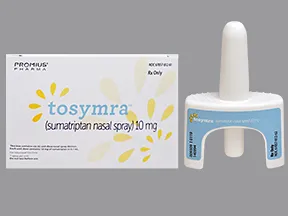 | |
| Tosymra nasal - | 10 mg/actuation liquid | 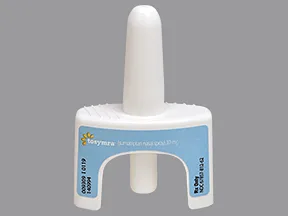 | |
| sumatriptan nasal - | 5 mg/actuation liquid | 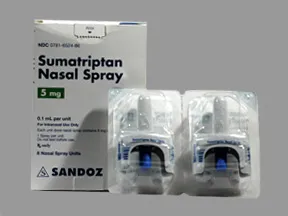 | |
| sumatriptan nasal - | 20 mg/actuation liquid |  | |
| sumatriptan nasal - | 5 mg/actuation liquid | 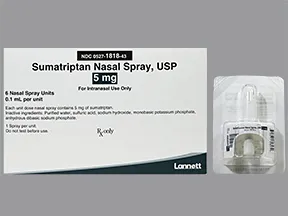 | |
| sumatriptan nasal - | 20 mg/actuation liquid | 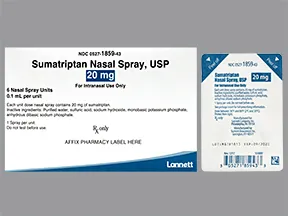 |
Copyright © 2010 First DataBank, Inc.
Patient Handout
sumatriptan nasal
SUMATRIPTAN SPRAY - NASAL
(SOO-ma-TRIP-tan)
COMMON BRAND NAME(S): Imitrex, Tosymra
USES: Sumatriptan is used to treat migraines. It helps to relieve headache, pain, and other migraine symptoms (including nausea, vomiting, sensitivity to light/sound). Prompt treatment helps you return to your normal routine and may decrease your need for other pain medications. Sumatriptan belongs to a class of drugs known as triptans. It affects a certain natural substance (serotonin) that causes narrowing of blood vessels in the brain. It may also relieve pain by affecting certain nerves in the brain.Sumatriptan does not prevent future migraines or lessen how often you get migraine attacks.
HOW TO USE: Read the Patient Information Leaflet and Instructions for Use if available from your pharmacist before you start using sumatriptan spray and each time you get a refill. This medication comes in different brands with different strengths. Carefully read and follow the instructions for your brand. If you have any questions, ask your doctor or pharmacist.This product is for use in the nose only. Remove the sumatriptan spray from the package only when you are ready to use it. Do not test or prime the spray before use. Doing so will make you lose the dose.Use this medication at the first sign of a migraine as directed by your doctor, usually 1 spray into one nostril. Avoid spraying into your eyes. Gently blow your nose before using this medication. Keeping your head upright, close one nostril by pressing with your index finger on one side of your nose. You may tilt your head back slightly to keep the medicine from dripping out of your nose. Place the nozzle of the spray device into the other nostril and breathe in gently as you press the plunger. Keep your head upright, remove the nozzle from your nose, and gently breathe in through your nose and out through your mouth for 10 to 20 seconds. Your nose may feel wet inside and you may notice a slight taste after using the spray. This is normal.If there is no improvement in your symptoms, do not take more doses of this medication before talking to your doctor. If your symptoms are only partly relieved, or if your headache comes back, you may use another dose after at least 1 or at least 2 hours (depending on your brand). The dosage is based on your medical condition and response to treatment.If you have a higher risk for heart problems (see Precautions), your doctor may perform a heart exam before you start taking sumatriptan. He/she may also direct you to take your first dose of this medication in the office/clinic to monitor for serious side effects (such as chest pain). Talk to your doctor for details.If you are using drugs for migraine attacks on 10 or more days each month, the drugs may actually make your headaches worse (medication overuse headache). Do not use medications more often or for longer than directed. Tell your doctor if you need to use this medication more often, or if the medication is not working as well, or if your headaches get worse.
SIDE EFFECTS: Unusual taste or irritation/numbness/tingling of the nose or throat may occur after using the spray. Flushing, feelings of tingling/numbness/prickling/heat, tiredness, weakness, drowsiness, or dizziness may also occur. If any of these effects last or get worse, tell your doctor or pharmacist promptly.Remember that this medication has been prescribed because your doctor has judged that the benefit to you is greater than the risk of side effects. Many people using this medication do not have serious side effects.This medication may raise your blood pressure. Check your blood pressure regularly and tell your doctor if the results are high.Tell your doctor right away if you have any serious side effects, including: blue fingers/toes/nails, cold hands/feet, hearing changes, mental/mood changes.Sumatriptan can commonly cause chest/jaw/neck tightness, pain, or pressure that is usually not serious. However, these side effects are like symptoms of a heart attack, which may include chest/jaw/left arm pain, shortness of breath, or unusual sweating. Get medical help right away if these or other serious side effects occur, including: fast/irregular heartbeat, fainting, severe stomach/abdominal pain, bloody diarrhea, seizure, signs of a stroke (such as weakness on one side of the body, trouble speaking, sudden vision changes, confusion).This medication may increase serotonin and rarely cause a very serious condition called serotonin syndrome/toxicity. The risk increases if you are also taking other drugs that increase serotonin, so tell your doctor or pharmacist of all the drugs you take (see Drug Interactions section). Get medical help right away if you develop some of the following symptoms: fast heartbeat, hallucinations, loss of coordination, severe dizziness, severe nausea/vomiting/diarrhea, twitching muscles, unexplained fever, unusual agitation/restlessness.A very serious allergic reaction to this drug is rare. However, get medical help right away if you notice any symptoms of a serious allergic reaction, including: rash, itching/swelling (especially of the face/tongue/throat), severe dizziness, trouble breathing.This is not a complete list of possible side effects. If you notice other effects not listed above, contact your doctor or pharmacist.In the US -Call your doctor for medical advice about side effects. You may report side effects to FDA at 1-800-FDA-1088 or at www.fda.gov/medwatch.In Canada - Call your doctor for medical advice about side effects. You may report side effects to Health Canada at 1-866-234-2345.
PRECAUTIONS: Before using sumatriptan, tell your doctor or pharmacist if you are allergic to it; or if you have any other allergies. This product may contain inactive ingredients, which can cause allergic reactions or other problems. Talk to your pharmacist for more details.Before using this medication, tell your doctor or pharmacist your medical history, especially of: blood circulation problems (for example, in your legs, arms/hands, or stomach), certain types of headaches (hemiplegic or basilar migraine), heart problems (such as chest pain, irregular heartbeat, previous heart attack), liver disease, seizure, stroke or "mini-stroke" (transient ischemic attack).Certain conditions can increase your risk for heart problems. Tell your doctor if you have any of these conditions, including: high blood pressure, high cholesterol, diabetes, family history of heart disease, overweight, smoker, postmenopausal (women), age more than 40 years (men).This drug may make you dizzy or drowsy. Alcohol or marijuana (cannabis) can make you more dizzy or drowsy. Do not drive, use machinery, or do anything that needs alertness until you can do it safely. Limit alcoholic beverages. Talk to your doctor if you are using marijuana (cannabis).Before having surgery, tell your doctor or dentist about all the products you use (including prescription drugs, nonprescription drugs, and herbal products).The risk of heart disease, liver disease, and high blood pressure increases with age. Older adults may be more sensitive to the side effects of this drug, especially increased blood pressure and heart problems.During pregnancy, this medication should be used only when clearly needed. Discuss the risks and benefits with your doctor.This drug passes into breast milk in small amounts. Consult your doctor before breastfeeding.
DRUG INTERACTIONS: Drug interactions may change how your medications work or increase your risk for serious side effects. This document does not contain all possible drug interactions. Keep a list of all the products you use (including prescription/nonprescription drugs and herbal products) and share it with your doctor and pharmacist. Do not start, stop, or change the dosage of any medicines without your doctor's approval.Taking MAO inhibitors with this medication may cause a serious (possibly fatal) drug interaction. Do not take any MAO inhibitors (isocarboxazid, linezolid, metaxalone, methylene blue, moclobemide, phenelzine, procarbazine, rasagiline, safinamide, selegiline, tranylcypromine) during treatment with this medication. Most MAO inhibitors should also not be taken for two weeks before treatment with this medication. Ask your doctor when to start or stop taking this medication.The risk of serotonin syndrome/toxicity increases if you are also taking other drugs that increase serotonin. Examples include street drugs such as MDMA/"ecstasy," St. John's wort, certain antidepressants (including SSRIs such as fluoxetine/paroxetine, SNRIs such as duloxetine/venlafaxine), among others. The risk of serotonin syndrome/toxicity may be more likely when you start or increase the dose of these drugs.If you also take any ergotamine medication (such as dihydroergotamine) or other "triptan" drugs (such as zolmitriptan, rizatriptan), you will need to separate your sumatriptan dose from your dose of these other medications to lessen the chance of serious side effects. Ask your doctor how long you should wait between your doses of these drugs.
OVERDOSE: If someone has overdosed and has serious symptoms such as passing out or trouble breathing, call 911. Otherwise, call a poison control center right away. US residents can call their local poison control center at 1-800-222-1222. Canada residents can call a provincial poison control center.
NOTES: Do not share this medication with others.Certain foods, beverages, or food additives (such as red wine, cheese, chocolate, monosodium glutamate) as well as lifestyle patterns such as irregular eating/sleeping habits or stress may bring on a migraine headache. Avoiding these "triggers" may help lessen migraine attacks. Consult your doctor for more details.Lab and/or medical tests (such as blood pressure) may be done while you are using this medication. Keep all medical and lab appointments. Consult your doctor for more details.
MISSED DOSE: Not applicable. (See How to Use section.)
STORAGE: Different brands of this medication have different storage needs. Check the product package for instructions on how to store your brand, or ask your pharmacist. Keep all medications away from children and pets.Do not flush medications down the toilet or pour them into a drain unless instructed to do so. Properly discard this product when it is expired or no longer needed. Consult your pharmacist or local waste disposal company.
Information last revised March 2024. Copyright(c) 2024 First Databank, Inc.
IMPORTANT: HOW TO USE THIS INFORMATION: This is a summary and does NOT have all possible information about this product. This information does not assure that this product is safe, effective, or appropriate for you. This information is not individual medical advice and does not substitute for the advice of your health care professional. Always ask your health care professional for complete information about this product and your specific health needs.
Formulary
Adding plans allows you to compare formulary status to other drugs in the same class.
To view formulary information first create a list of plans. Your list will be saved and can be edited at any time.
Adding plans allows you to:
- View the formulary and any restrictions for each plan.
- Manage and view all your plans together – even plans in different states.
- Compare formulary status to other drugs in the same class.
- Access your plan list on any device – mobile or desktop.







